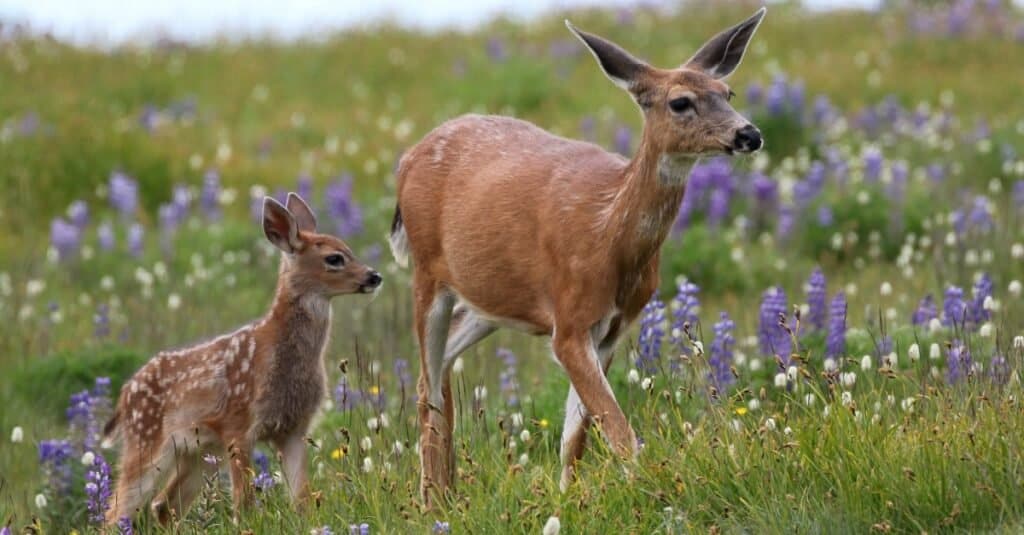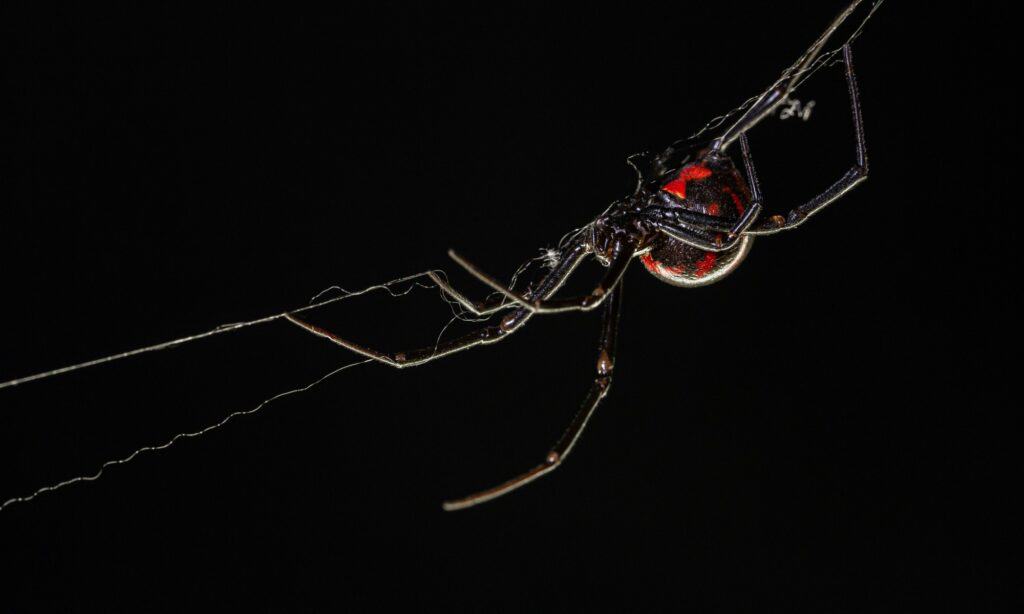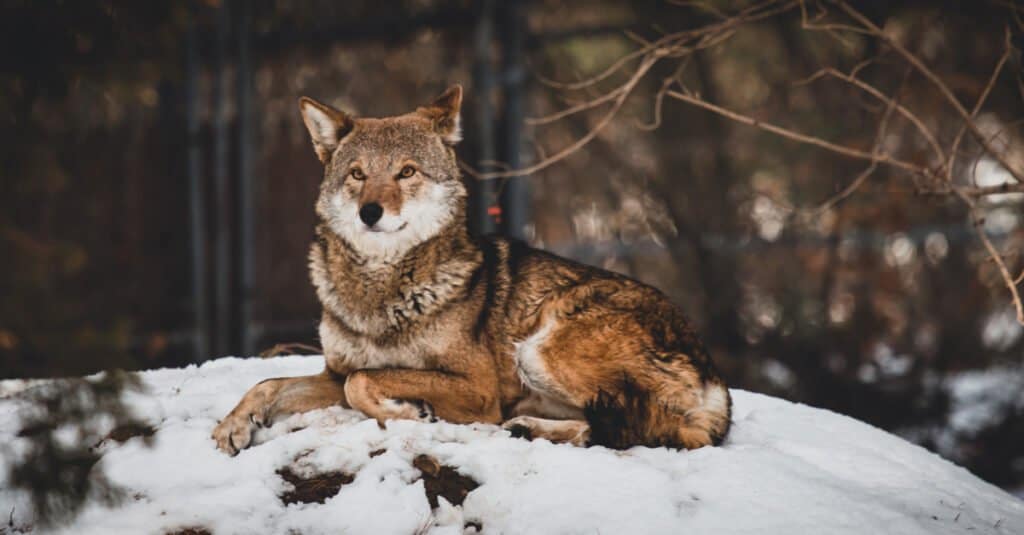Arkansas is home to about 3 million people and covers a number of habitats. In the north of Arkansas sits hills and lakes while the south is warm enough year-round to support an alligator population. Let’s dig into some of the most dangerous animals in Arkansas.
The Most Deadly Animal in Arkansas: Deer

Deer cause an estimated 20,710 collisions in Arkansas per year
©iStock.com/randimal
The state animal of Arkansas is the white-tailed deer. Picture a long-eyelashed cartoon deer munching daisies in a big open field. Not exactly a “deadly” animal! But in reality, deer cause the highest number of fatalities in many states. According to State Farm Insurance, there were 20,710 collisions with vehicles and deer last year, and that is just in Arkansas! In the US there is an average of 200 human deaths a year resulting from deer-vehicle collisions. Multiple agencies seek to educate the public about safe driving standards to avoid more deer collisions such as being more aware of deer in the fall and during the hours of 6-9pm when deer are more active. Learning to coexist with animals of all kinds is important for both humans and animals.
Are Black Bears the deadliest animals in Arkansas?

Black bears were almost hunted out of Arkansas in the 1950s but their population has rebounded.
©BGSmith/Shutterstock.com
If black bears were writing an article about the dangerous predators of bears they would say humans are the deadliest! Black bears were hunted to near extinction in Arkansas back in the 1950s. The Arkansas Game and Fish Commission took action and created a program to reintroduce 254 bears back into the Ozark and Ouachita mountains. These efforts took place between 1958 and 1968 and now there are an estimated 3,000-5,000+ black bears in Arkansas today. The chances of being injured, attacked or killed by a black bear are extremely rare with only 67 fatalities in the US from 1900 on. If you are camping be sure to keep all food in a bear bag and store it away from your sleeping space, if hiking through bear country it is better to leave your dog at home due to the instances of bear attacks also involving dogs. Also, make noise when hiking so that you do not startle a bear by accident. Black bears are mostly found in the Interior Highlands of the state’s northwest corner.
Are there any deadly snakes in Arkansas?

Copperheads lie throughout most of Arkansas and are responsible for more bites than any other venomous snake in the United States.
©iStock.com/David Kenny
There are six species of venomous snakes in Arkansas. If you can’t tell the difference between a venomous and nonvenomous snake, it’s always best to err on the side of caution. In fact, it might be best to just keep your distance from all snakes. The majority of incidents involving snake bites are from people who try to pick up a snake or provoke them in some way. The six species of venomous snakes in Arkansas are:
- Timber rattlesnakes
- Western diamond-backed rattlesnakes
- Western pygmy rattlesnakes
- Northern cottonmouth
- Eastern copperhead
- Coral Snakes
All of these, except for the coral snake, are pit vipers and have retractable fangs that produce venom. In most cases these snakes will give fair warning before striking. They will get into a coiled position, shake their tails to produce a rattle noise (thus the name rattlesnake) and they may show their fangs before striking. Ignoring these signs may lead to a snake defending itself with a bite.
A recent study by Poison Control Centers listed the rattlesnake as the snake causing the most fatalities with 43 out of the known 68 fatalities being rattlesnakes. This was from the period between 1983-2019. This averages out to only 5-6 people being killed a year by snakes in the US. While copperheads deliver the most bites of any venomous rates, their bites only carry a .01% fatality rate. If bitten by a venomous snake it’s important to remain calm and seek medical attention. Even if not fatal venomous snake bites can be quite painful and medical centers throughout the state carry antivenom that can treat bites.
Are there venomous spiders in Arkansas

Black widow bites can be extremely painful but are rarely fatal.
©iStock.com/AmericanWildlife
The two main culprits in Arkansas are the brown recluse and black widows. Brown recluse spiders are small brown spiders with long legs that can be found both indoors and outdoors. They tend to stay out of the way of humans but do live in homes and can even settle into the insulation in your walls. Woodpiles are a favorite place for spiders and rodents to make their home so be cautious around these areas. A brown recluse bite has a toxin that destroys cells so it can create a damaged pivot in your skin that can take weeks to heal. But their bites are rarely fatal. Black widow spiders are larger than brown recluses and are much more venomous, even so, it is extremely rare for a black widow bite to be fatal. In the US there are only an average of 7 spider-related fatalities each year.
Are wolves the deadliest animals in Arkansas?

Red wolves used to live in Arkansas but today are absent from the state and mostly exist in captive breeding programs.
©mruizseda/Shutterstock.com
The mascot of the Arkansas State University is the red wolf. However, they no longer exist in the state of Arkansas, in fact, there are only a few left that live in North Carolina, and when I say a few, I mean there are only 20-30 left according to the IUCN. The IUCN Redlist has the Red Wolf listed as “Critically Endangered” and is federally protected. There are also around 240 red wolves in captive breeding facilities to help manage the specie’s future.
How did there get to be so few Red wolves? As more people moved to Arkansas the more they took over the wolves’ habitats and ordered organized predator control programs hunting the wolves so that they would not kill their livestock. There have been reports of gray wolf sightings in the state, but they’re most likely wolf-dog hybrids or large coyotes. There aren’t believed to be breeding populations of gray wolves anywhere near Arkansas.
Do alligators live in Arkansas?
Similar to the black bears and red wolves the number of alligators in Arkansas was diminished by habitat loss and hunting. By 1960 several agencies stepped in to save them. In 1961 the State enacted regulations to protect the alligator and the US Congress passed legislation in 1967 that listed the alligator as an endangered species. By 1987 it was delisted and received the recovered status, today the IUCN has it listed as “Least Concern”. Good news for the alligator, maybe bad news if you find one on the third hole of your golf course! Now it is legal to hunt alligators again, but it is highly regulated and you have to have a permit.
So how dangerous are these creatures? Dangerous? Yes…deadly? Rarely. In the US, in the southwest states (between 1999-2019), there have only been 10 human fatalities caused by alligators (according to the CDC). One website made a suggestion that seems obvious, but it is good advice to not let children or pets swim in water that has alligators in it, probably applies to everyone! It’s estimated that there are about 2,000 to 3,000 alligators in Arkansas.
A list of the most dangerous animals in Arkansas
The most dangerous animals in Arkansas include:
- Alligators
- Black Bears
- Brown Recluses
- Black Widows
- Timber rattlesnakes
- Western diamond-backed rattlesnakes
- Western pygmy rattlesnakes
- Northern cottonmouth
- Eastern copperhead
- Coral Snakes
- Deer
The photo featured at the top of this post is © iStock.com/Maryna Rayimova
Thank you for reading! Have some feedback for us? Contact the AZ Animals editorial team.






